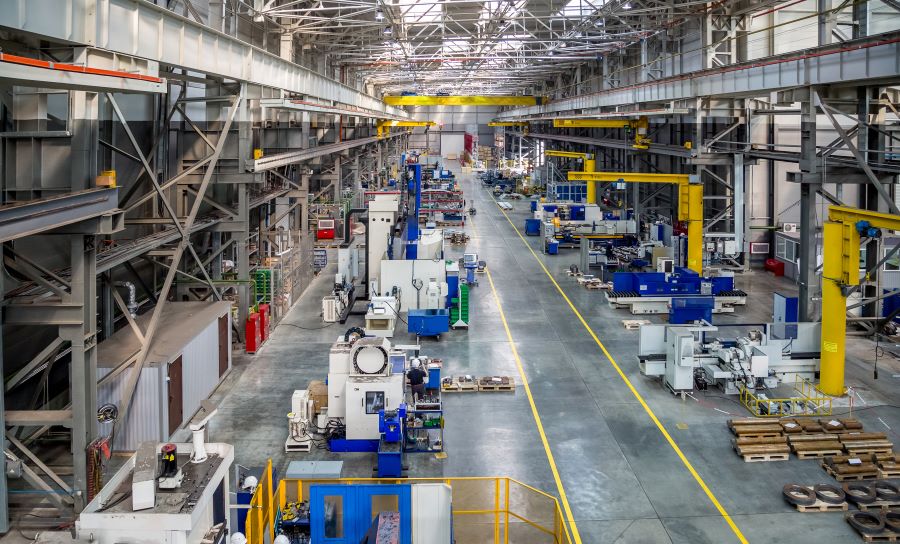How to Increase Production Efficiency for Steel and Metals Manufacturing
With U.S. demand for fabricated metal products expected to rise 1.3% per year through 2024, are your steel manufacturing operations prepared for the challenge?
Besides the rising demand for metal products, steel manufacturers must also adapt in the face of further challenges, such as competition with foreign manufacturers like China, who is not only the leading steel manufacturer but also accounts for more than 50% of global steel consumption. Steel companies must also contend with supply uncertainty, skill shortages, and the need to shift to climate-friendly processes to continue to thrive. Therefore, now is the time to optimize your manufacturing process to increase efficiency.
Here are eight ways you can increase efficiency for steel manufacturing.
Automate Processes
Relieve your employees of menial tasks and working long hours by implementing automation. Fully automated cranes will speed up steel manufacturing for scrap, casting and slab handling. Dip tanks and coil storage operations are also good candidates for automation. Look for repetitious work that can be more easily completed by automation than human workers.
By automating processes, the amount of time it takes to complete a job can be cut drastically (up to 2 to 3 times less in most case studies). Furthermore, industrial automation in steel plants can also improve system analytics and diagnostics, simplifying maintenance, troubleshooting and operation.
With the use of industrial robots in steel plants growing at 55% per year, it’s clear that the long-term ROI and the savings on maintenance and labor costs make automation well worth the investment.
Use Tracking Labels
Tracking labels provide valuable production data and insight so production managers can make informed decisions. They also provide the data that your automated systems need to operate. Production tracking will enhance productivity and can even eliminate compliance problems. Today, with temperature-resistant labels and labels that can resist extreme conditions, there is no reason not to use them.
If you already have a label system, look at optimizing its use. An effective label will clearly lay out information that helps people in the supply chain understand how to care for the product and where to transport it. As such, labels should be prioritized as a vital asset to use during all stages of the manufacturing process.
Update and Maintain Equipment and Machinery
Prevent downtime and machine breakdowns by investing in high-quality machinery. The better the machinery, the fewer accidents and time-consuming problems it will cause. While it may be tempting to buy cheaper equipment, inferior equipment can end up costing more in upkeep in the long run. Therefore, it’s important to invest in quality machinery and tools. In addition to quality machines, make sure that operators are trained on them. Invest in additional training and refresher courses.
Nothing slows down operations like malfunctioning equipment. Regular equipment maintenance will ensure equipment is ready for work now and well into the future. By regularly performing maintenance, you can make sure your equipment has the vital things it needs to work such as oil, working brakes, and no mechanical issues. This will ensure the equipment is operating at peak performance. Consider implementing predictive maintenance measures using a label or barcode scanner on the machinery. It’s a simple step that will increase efficiency.
Provide Efficiency Training for Employees
Train your employees to be more productive and efficient in the workplace. Regular training can set employees up for success and ensure that your team is aligned on the business goals, in addition to providing tips on how they can improve their processes and reduce workload.
Microbreaks are also proven to help with employees' well-being and productivity. Encourage employees to take full advantage of their breaks to stretch their legs, rest so they can work fresh, and even socialize.
Reorganize Working Spaces
A crowded workspace will not only make employees feel uncomfortable in the workplace but also be a lot less productive. Employees need ample space for completing tasks, privacy and concentration. Ensuring workspaces are clear of obstacles throughout the workplace will also minimize accidents and assure your employees you care about their well-being.
If necessary, rearrange your facilities to minimize the number of actions your employees need to take to complete a task. If your employees must walk far or even to another floor to get to a piece of equipment they use regularly, it could waste time and energy.
Set Realistic Deadlines
Although the goal should be to finish every project in as little time as possible, unrealistic deadlines can have a detrimental effect on morale and quality. Work together as a team to set realistic deadlines. Setting deadlines that are too tight can affect productivity, increase stress, and create a dangerous and frustrating workspace.
Gather feedback from your metal workers and project managers to ensure the deadlines are reasonable. Encourage a work atmosphere that motivates employees, so they feel equipped with the necessary tools and time to achieve their goals.
Invest in a Vendor Management System
A vendor management system (VMS) is a centralized platform that stores all supplier data such as pricing, supplier information, contract details, delivery timeframes, customer service quality and more. On average, an organization that uses a VMS solution to control spending saves around 10 to 15 percent of contingent workforce costs, with many companies seeing savings in as soon as six months.
This cloud-based software provides tools for onboarding suppliers, monitoring their performance and ensuring compliance. Work with a managed service provider (MSP) to handle the monitoring and maintenance of the program.
With a VMS, you or your MSP can speed up communication with suppliers to ensure supplies will arrive on time, thus saving you time otherwise spent manually managing suppliers via spreadsheet or email. This system will also notify stakeholders of any changes, keep track of conversions, and allow you to procure additional supplies when necessary.
Encourage Cross-Team Training Collaboration
Encouraging cross-team collaboration can ease pressure, increase motivation, and create a more productive and efficient workplace. If one team has a heavier load than normal, see if another team can take on additional tasks to ensure the job is completed in a timely manner. This kind of collaboration will not only encourage team togetherness, but will also widen employees' knowledge and skills.
Consider using an outside provider to manage cross-team collaborations. They can set up the sessions and provide training materials that will ensure the lessons stick and are sustainable.
Increase Efficiency for Steel Manufacturing with GO2 Partners
During this time of labor shortage, increasing efficiency for steel manufacturing is essential for staying ahead of the curve, saving costs and improving efficiency. There’s also never been a better time to review your current processes and identify opportunities for improvement.
GO2 Partners is here to help you with your operation and marketing needs. GO2’s experience in the metals industry, as well as our cross-functional teams, industry-leading label services and managed service programs, mean we are a one-stop shop for the metals and steel industry. We will help you optimize productivity, increase profitability and make good use of your resources. Contact us today!
Share this
You May Also Like
These Related Stories

5 Ways to Boost Efficiency in Manufacturing

Guide to RFID Technology for Manufacturing

